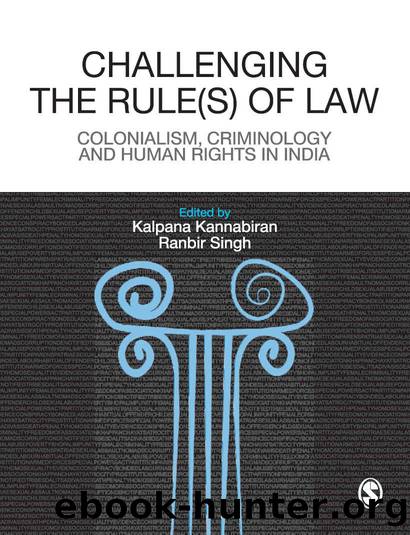Challenging The Rules(s) of Law by Kalpana Kannabiran & Ranbir Singh

Author:Kalpana Kannabiran & Ranbir Singh [Kannabiran, Kalpana & Singh, Ranbir]
Language: eng
Format: epub
Publisher: SAGE Publications
Published: 2008-09-30T18:30:00+00:00
Source: Andhra Pradesh Civil Liberties Committee, Life Liberty and Livelihood: Civil Liberties in Andhra Pradesh Vol. I, 1996, pp. 38â39.
NOTES & REFERENCES
1. The first Indian Law Commission was set up by a government order of 15 June 1835 with the following members: T.B. Macaulay, J.M. Macleod, G.W. Anderson and F. Millett. It laid the draft of the penal code before the Governor-General of India on 2 May 1836, which was finalised for print in October 1837.
2. For a detailed discussion regarding this episode, see Chapter 1 in Donogh, W.R. 1917. The History and Law of Sedition. Calcutta: Spink and Co. The Tilak and Gandhi trials were held under Section 124A (sedition).
3. Appendix, Note C in Cameron, C.H. and D. Eliot. 1888. The Indian Penal Code as Originally Framed in 1837, The Second Report on the Indian Penal Code by the Indian Law Commissioners, p. 117. Madras: Higginbotham and Co.
4. See Gross, Oren. 2001. âCutting Down Trees: Law Making Under the Shadow of Great Calamitiesâ, in Ronald D. Daniels, Patrick Macklem and Kent Roach (eds), The Security of Freedom: Essays on Canadaâs Anti-Terrorism Bill, p. 41. Toronto: University of Toronto Press. Carl J. Friedrich suggests that âreasons of stateâ are considerations, which exist âwhenever it is required to insure [that] the survival of the state must be done by the individuals responsible for it, no matter how repugnant such an act may be to them in their private capacity as decent and moral menâ. Friedrich, Carl J. 1957. Constitutional Reason of StateâThe Survival of the Constitutional Order, pp. 4â5. Providence: Brown University Press.
5. Ever since the enactment of the PDA in 1950, as Upendra Baxi points out, the Indian legal system has managed the coexistence of the Preventive Detention System (PDS), an institution authorised by the Constitution of India itself, with the fundamental right to personal liberty. The preventive detention legislation has been increasingly used not just to deny fundamental rights to the political opposition but also as a parallel legal system in aid of the Criminal Justice System (CJS). See Baxi, Upendra. 1982. The Crisis of the Indian Legal System. New Delhi: Vikas, p. 30.
6. See for details of this formulation Singh, Ujjwal Kumar. 2004. âState and the Emerging Interlocking Legal Systems in India: Permanence of the Temporaryâ, Economic and Political Weekly, 10â16 January, 39(2).
7. Hillyard, Paddy. 1993. Suspect Community: Peopleâs Experience of Terrorism Acts in Britain, p. 263. London: Pluto Press.
8. Sim, J. and P.A. Thomson. 1983. âThe Prevention of Terrorism Actâ, Journal of Law and Society, 10(1): 75.
9. The table has been drawn on the basis of data given in the Shah Commission Report (1978), Chapter XIX, âArrests and Detentions during the Emergencyâ, pp. 1â152.
10. The Shah Commission Report 1978, p. 58.
11. Ibid., p. 64.
12. Ibid., p. 96.
13. See for details, the study of V.S. Rekhi cited in Ansari, Iqbal. 1986. âPreventive Detention: Its Incompatibility with the Rule of Lawâ, in A.R. Desai (ed.), Violation of Democratic Rights in India, Bombay: Popular Prakashan.
14. Ram, Mohan. 1986.
Download
This site does not store any files on its server. We only index and link to content provided by other sites. Please contact the content providers to delete copyright contents if any and email us, we'll remove relevant links or contents immediately.
Day by Elie Wiesel(2721)
The Age of Genius by A. C. Grayling(2544)
Gideon's Spies: The Secret History of the Mossad by Gordon Thomas(2305)
The Gulag Archipelago (Vintage Classics) by Aleksandr Solzhenitsyn(2048)
FATWA: Hunted in America by Pamela Geller(1973)
Columbine by Dave Cullen(1824)
Men Explain Things to Me by Rebecca Solnit(1694)
The Rule of Law by Bingham Tom(1653)
Anatomy of Injustice by Raymond Bonner(1622)
Examples & Explanations: Administrative Law by William F. Funk & Richard H. Seamon(1605)
Three Cups of Tea by Greg Mortenson(1582)
That Every Man Be Armed by Stephen P. Halbrook(1549)
The Source by James A. Michener(1540)
ADHD on Trial by Michael Gordon(1533)
Future Design by Unknown(1473)
Gideon's Spies by Gordon Thomas(1472)
Palestinian Walks by Raja Shehadeh(1459)
Constitutional Theory by Carl Schmitt(1416)
Nothing to Envy by Barbara Demick(1389)
